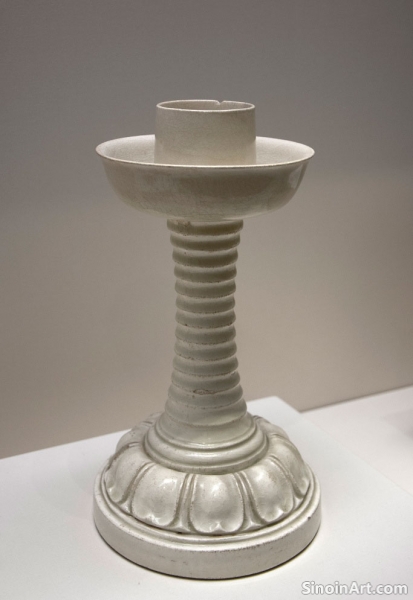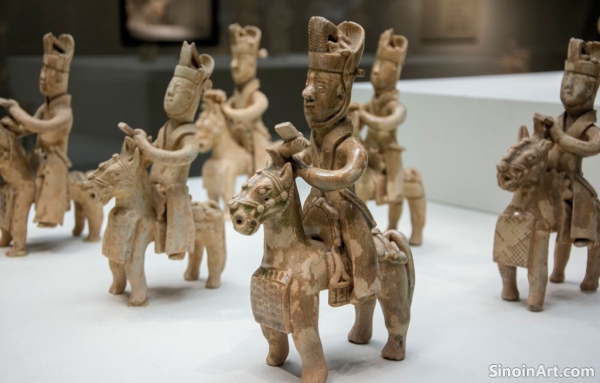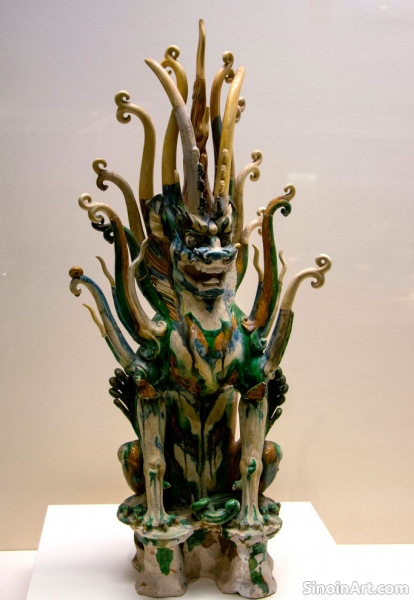The Economic Importance of Tang Ceramic Production
|
Ceramic production played a significant economic role in the Tang Dynasty, both domestically and through export. The industry provided employment to a large number of people and contributed significantly to the wealth of the empire. The production of ceramics was a major economic activity of the time.  The production of sancai wares, Yue celadon, and other ceramics was centered in various kiln sites throughout China, each contributing to the overall ceramic output of the era. Each kiln site became a center of both art and industry. The large output of the kilns helped to support the empire.  Tang ceramics were traded throughout Asia, and they have been found in archaeological sites in various countries, attesting to their importance in international commerce. The widespread trade of Tang ceramics also helped to spread Chinese artistic ideas and techniques. These pieces traveled to all points of the known world.  The trade in ceramics stimulated economic growth and encouraged the development of new technologies and production methods. The economic influence of pottery production was immense. The trade was mutually beneficial to China and the various trading partners of the era. The economic importance of Tang ceramic production highlights not only the aesthetic achievements of the time but also the key role of ceramic production in the economic and cultural life of the Tang Dynasty. The trade of ceramics was an essential element of Tang economic success. |
Tag : Tang ceramics trade, Chinese economy, Ceramic production, Export pottery, Tang Dynasty
Related information
- Sancai Ware: A Symphony of Three Colors
- Yue Ware Celadon: Subtle Elegance in Green
- The Dawn of Celadon Splendor
- Tang Ceramics and the Tea Ceremony
- The Enduring Legacy of Tang Dynasty Ceramics
Sancai, meaning “three-color” in Chinese, is perhaps the most iconic ceramic ware of the Tang Dynasty. These vibrant and richly glazed pieces are instantly recognizable for their combination of green, amber, and cream or straw-yellow glazes. While the term suggests a limited palette, the actual range of colors could vary, sometimes incorporating blues and purples, creating a dazzling visual spectacle. Sancai ware wasn’t just about color; it was a bold statement of Tang aesthetics and technical prowess.
Yue ware, a Tang Dynasty celadon, is characterized by subtle green glazes, elegant forms, and fine, smooth bodies, reflecting a quieter aesthetic and influencing later celadon traditions across Asia.
The Tang Dynasty (618-907 AD) represents a crucial period in the history of Chinese ceramics, particularly in the development and refinement of celadon wares. While not as dramatically innovative as the later Song dynasty, the Tang era saw a significant leap in kiln technology, material preparation, and artistic understanding that laid the groundwork for future ceramic masterpieces. Celadon, with its subtle green hues reminiscent of jade, enjoyed immense popularity, favored by both the imperial court and the burgeoning merchant class. Tang celadon wasn't just about mimicking jade; it was about capturing the essence of natural beauty and the philosophical ideals of the time.
While not as central as in later periods, the tea ceremony was beginning to gain popularity during the Tang Dynasty, and this had a subtle but significant impact on ceramic production. The growing appreciation for tea and the rituals surrounding its consumption influenced the development of specific ceramic forms and styles. The Tang tea culture, while not as formalized as in later dynasties, laid the groundwork for the widespread use of ceramics in tea service.
The ceramic art of the Tang Dynasty represents a peak in Chinese ceramic history, leaving an enduring legacy that continues to inspire artists, collectors, and scholars today. The innovative techniques, vibrant colors, and elegant forms of Tang wares established a new standard for ceramic production, influencing subsequent generations of potters both in China and around the world.